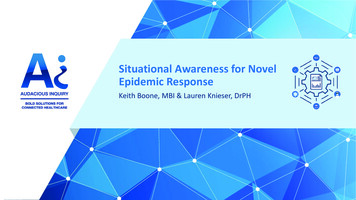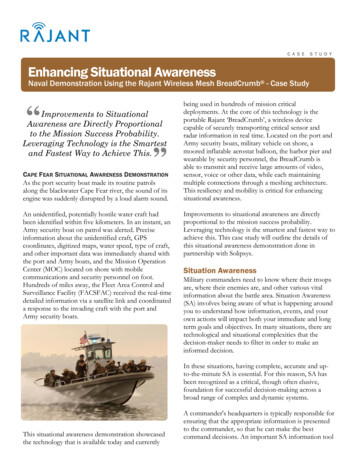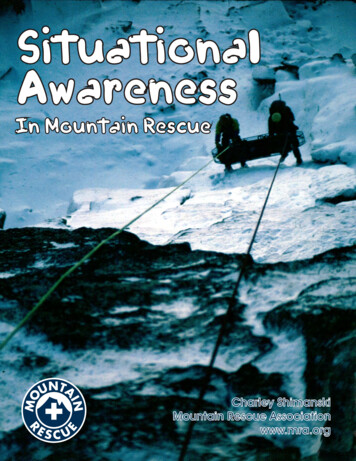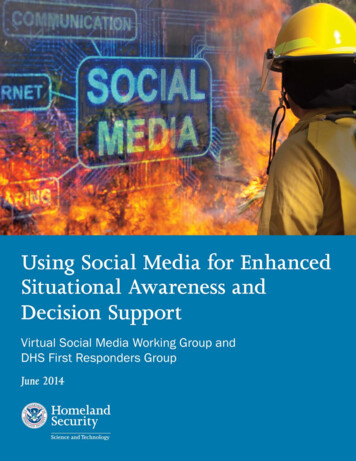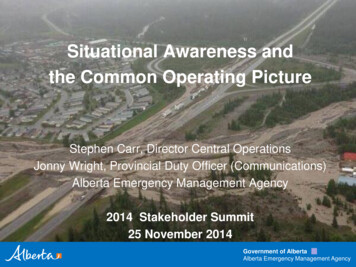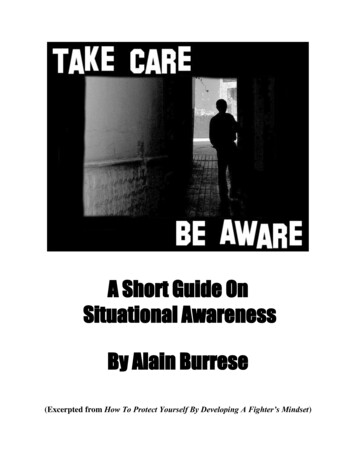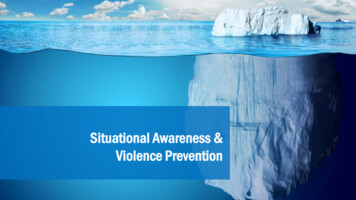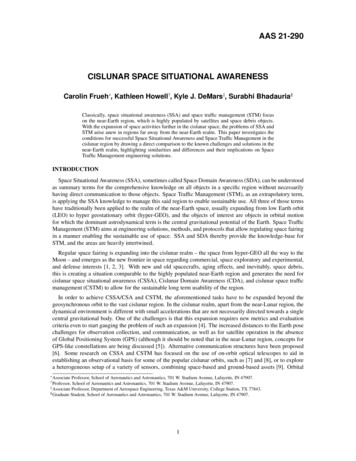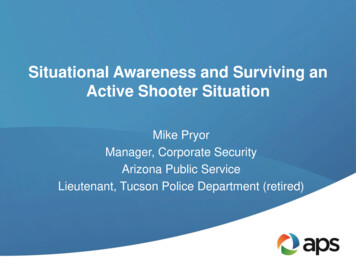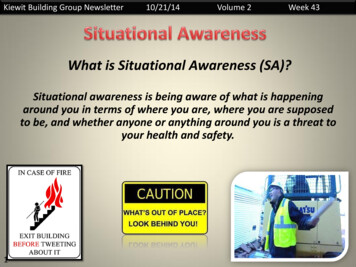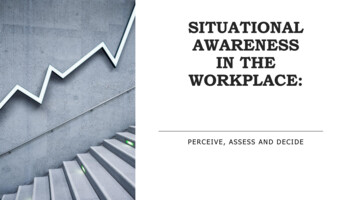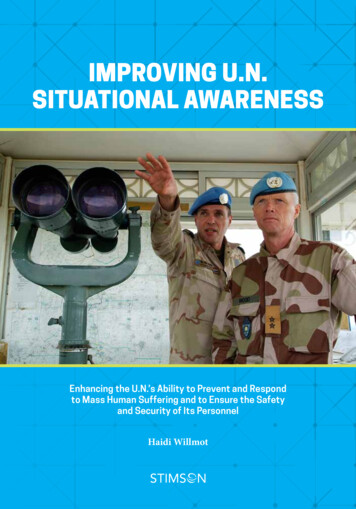
Transcription
IMPROVING U.N.SITUATIONAL AWARENESSEnhancing the U.N.’s Ability to Prevent and Respondto Mass Human Suffering and to Ensure the Safetyand Security of Its PersonnelHaidi Willmot
IMPROVING U.N.SITUATIONAL AWARENESSEnhancing the U.N.’s Ability to Prevent and Respondto Mass Human Suffering and to Ensure the Safetyand Security of Its PersonnelHaidi WillmotAUGUST 2017
Copyright 2017 by the Stimson Center. All rights reserved.Printed in the United States of America.All photographs used in this report are via UN Photo.Photography credits as follows:Rick Bajornas: page 70Ky Chung: page 52Harandane Dicko: page 103Manuel Elias: pages 16 and 37Albert González Farran: page 40Kim Haughton: page 125Sylvain Liechti: pages 72 and 110Hanne Olafsen: CoverMartine Perret: pages 12 and 113Evan Schneider: page 82Neeraj Singh: page 50UNAMA: page 18Fardin Waezi: page 6Visit www.stimson.org for more information about Stimson.
CONTENTSAcknowledgements . . . . . . . . . . . . . . . . . . . . . . . . . . . . . . . . . . . . . . . . . . . . . . . . . . 7About the Author and Stimson . . . . . . . . . . . . . . . . . . . . . . . . . . . . . . . . . . . . . . . . 8Acronyms and Abbreviations . . . . . . . . . . . . . . . . . . . . . . . . . . . . . . . . . . . . . . . . . . 9Executive Summary . . . . . . . . . . . . . . . . . . . . . . . . . . . . . . . . . . . . . . . . . . . . . . . . . 13Conceptual Clarity . . . . . . . . . . . . . . . . . . . . . . . . . . . . . . . . . . . . . . . . . . . . . . . . . . 19Situational Awareness . . . . . . . . . . . . . . . . . . . . . . . . . . . . . . . . . . . . . . . . . . . 19Intelligence . . . . . . . . . . . . . . . . . . . . . . . . . . . . . . . . . . . . . . . . . . . . . . . . . . . . 20Early Warning . . . . . . . . . . . . . . . . . . . . . . . . . . . . . . . . . . . . . . . . . . . . . . . . . . 21Analysis and Assessment . . . . . . . . . . . . . . . . . . . . . . . . . . . . . . . . . . . . . . . . . 21Situational Awareness within the U.N. . . . . . . . . . . . . . . . . . . . . . . . . . . . . . . . . . 25The Need for Improved Situational Awareness . . . . . . . . . . . . . . . . . . . . . . 25Past Efforts to Improve Situational Awareness . . . . . . . . . . . . . . . . . . . . . . 29Existing U.N. Entities and Processes . . . . . . . . . . . . . . . . . . . . . . . . . . . . . . . . . . . 41Headquarters Entities and Processes . . . . . . . . . . . . . . . . . . . . . . . . . . . . . . . 41Field Entities and Processes . . . . . . . . . . . . . . . . . . . . . . . . . . . . . . . . . . . . . . 47Opportunities and Challenges . . . . . . . . . . . . . . . . . . . . . . . . . . . . . . . . . . . . . . . . 53Opportunities . . . . . . . . . . . . . . . . . . . . . . . . . . . . . . . . . . . . . . . . . . . . . . . . . 54Challenges . . . . . . . . . . . . . . . . . . . . . . . . . . . . . . . . . . . . . . . . . . . . . . . . . . . . . 57Recommended Reforms . . . . . . . . . . . . . . . . . . . . . . . . . . . . . . . . . . . . . . . . . . . . . 73Culture . . . . . . . . . . . . . . . . . . . . . . . . . . . . . . . . . . . . . . . . . . . . . . . . . . . . . . . . 74Architecture . . . . . . . . . . . . . . . . . . . . . . . . . . . . . . . . . . . . . . . . . . . . . . . . . . . 75Policy, Process, Personnel, and Partnerships . . . . . . . . . . . . . . . . . . . . . . . . 78Annex A: Existing U.N. Entities and Processes . . . . . . . . . . . . . . . . . . . . . . . . . 83Annex B: Information and Analysis Centers . . . . . . . . . . . . . . . . . . . . . . . . . . . 114Annex C: Office of the Senior Advisor for Situational Awareness . . . . . . . . . 124Annex D: Processes and Products . . . . . . . . . . . . . . . . . . . . . . . . . . . . . . . . . . . . 126Endnotes . . . . . . . . . . . . . . . . . . . . . . . . . . . . . . . . . . . . . . . . . . . . . . . . . . . . . . . . . 131
Haidi Willmot6
Improving U.N. Situational AwarenessACKNOWLEDGEMENTSThis report is based on field visits to Colombia, Israel and the Occupied PalestinianTerritories, Jordan, Lebanon, South Sudan, Switzerland, Tunisia, the UnitedKingdom, and the United States of America, which took place October-December2016, as well as extensive desk research. It also incorporates perspectives from theworkshop “Improving U.N. Integrated Analysis” held by the Stimson Center onApril 21, 2017 in New York.The author is most grateful to the government of the United Kingdom for theirsupport of this project. She is also deeply appreciative to the many people in theUnited Nations family, at headquarters and in the field, at the Secretariat, agencies,and member state delegations, who engaged in thought-provoking discussions onthese challenging issues and offered valuable ideas, insights, and feedback. Shewould like to extend a special thanks to Ian Martin and Colin Keating for theiradroit chairing the above-noted workshop.The author would like to acknowledge the invaluable contributions of herStimson colleagues. She is appreciative to Madeline Vellturo for her excellentresearch assistance, organizational and administrative support, and patience. Sheis most grateful to Aditi Gorur, not only for her sound advice and substantivecontributions, but also for recognizing the importance of the project and herdynamic efforts to make it happen.Finally, the author would like to thank Suzie and Eric Willmot and Robertand Peggy Knott. Above all, she would like to thank Scott Sheeran, who workedresolutely on these issues while serving on the Security Council, believed in thisproject from the outset, and as always offered the greatest intellectual partnershipand support.7
Haidi WillmotABOUTAbout the AuthorHaidi Willmot is a non-resident fellow of the Stimson Center. She has extensiveUnited Nations experience, having worked for the United Nations at headquarters,in the field, and at the Australian Mission to the United Nations. Willmot wasintegrally involved in the establishment of the United Nations Operations andCrisis Center. She drafted the early warning strategy for the United Nations Missionin South Sudan, worked in the United Nations Peacekeeping Situation Center, andserved as a national intelligence analyst. In addition to publishing articles on arange of United Nations topics — including the protection of civilians, intelligence,safety and security, and peacekeeping law — in several peer-reviewed journals, shewas the lead editor of Protection of Civilians, published in 2016 by Oxford UniversityPress. Willmot holds a BA/LLB (Hons.) from the Australian National Universityand an MPhil in International Relations from the University of Cambridge.About StimsonThe Stimson Center is a nonpartisan policy research center working to solvethe world’s greatest threats to security and prosperity. Think of a modern globalchallenge: refugee flows, arms trafficking, terrorism. These threats cannot beresolved by a single government, individual, or business. Stimson’s award-winningresearch serves as a roadmap to address borderless threats through collective action.Our formula is simple: we gather the brightest people to think beyond soundbites,create solutions, and make those solutions reality. We follow the credo of one ofhistory’s leading statesmen, Henry L. Stimson, in taking “pragmatic steps towardideal objectives.” We are practical in our approach and independent in our analysis.Our innovative ideas change the world.8
Improving U.N. Situational AwarenessACRONYMS AND ABBREVIATIONSAEWUAnalysis and Early Warning UnitASGAssistant Secretary-GeneralCCACommon Country AnalysisCIMSCommon Information Management SystemCIUCriminal Intelligence UnitDESADepartment of Economic and Social AffairsDFSDepartment of Field SupportDPADepartment of Political AffairsDPIDepartment of Public InformationDPKODepartment of Peacekeeping OperationsDSSDepartment of Safety and SecurityEISASInformation and Strategic Analysis SecretariatEOSGExecutive Office of the Secretary-GeneralFPUFormed Police UnitGISGeospatial Information SystemsHICHumanitarian Information CenterHIPPOHigh-Level Independent Panel on Peace OperationsHRPHumanitarian Response PlanIACInformation and Analysis CenterIAHIntegrated Analysis HubIASCInter-Agency Standing CommitteeIIHIntegrated Information HubISRIntelligence, Surveillance, and ReconnaissanceJMACJoint Mission Analysis CenterJOCJoint Operations CenterMINUSMAUnited Nations Multidimensional IntegratedStabilization Mission in MaliMONUSCOUnited Nations Stabilization Missionin the Democratic Republic of CongoNAMNon-Aligned MovementNGONon-Governmental OrganizationOCHAOffice of the Coordination for Humanitarian Assistance9
Haidi WillmotOECDOrganization for Economic Cooperation and DevelopmentOHCHROffice of the High Commissioner for Human RightsOMAOffice of Military AffairsOPSCENEmergency Operations CenterPCCPolice-Contributing CountryPDAPeace and Development AdvisorRABResearch and Trend Analysis BranchRG REWPReference Group on Risk, Early Warning and PreparednessRMRRegional Monthly ReviewSGITTService for Geospatial, Informationand Telecommunication TechnologiesSIOCSecurity Information and Operations CenterSMCStrategic Military CellSOCSecurity Operations CenterSPMSpecial Political MissionSRSGSpecial Representative to the Secretary-GeneralTCCTroop-Contributing CountryTRSThreat and Risk ServiceUAVUnmanned Aerial VehicleU.K.United KingdomUMAICUnidad de Manejo y Análisis de Información ColombiaU.N.United NationsUNAMAUnited Nations Assistance Mission in AfghanistanUNCTUnited Nations Country TeamUNDAFUnited Nations Development Assistance FrameworkUNDPUnited Nations Development ProgrammeUNESCOUnited Nations Educational, Scientificand Cultural OrganizationUNHCRUnited Nations High Commissioner for RefugeesUNHQUnited Nations HeadquartersUNICEFUnited Nations International Children’s Emergency FundUNIFILUnited Nations Interim Force in LebanonUNMISSUnited Nations Mission in South SudanUNOCCUnited Nations Operations and Crisis Center10
Improving U.N. Situational EWHOWTOUnited Nations Office on Drugs and CrimeUnited Nations Operational Satellite Applications ProgramUnited Nations PoliceUnited Nations Situational Awareness SystemUnited Nations Support Mission in LibyaUnited Nations Assistance Mission in SomaliaUnited StatesWorld Food ProgrammeHealth Emergencies ProgramWorld Health OrganizationWorld Trade Organization11
Haidi Willmot12
Improving U.N. Situational AwarenessEXECUTIVE SUMMARYThe United Nations (U.N.) is mandated and resourced to prevent and respondto mass human suffering caused by conflict, natural disaster, and disease. Yet itis often criticized for failing to act in a timely way. There are many structural,political, and practical reasons for these failures, and the solutions are not easy.One important remedy lies in improving the U.N.’s situational awareness — thatis, its knowledge, understanding, and anticipation of a situation or event. Improvedsituational awareness cannot force U.N. decision makers to take more potentaction, but it can enable earlier and more informed decision making and removeone important cause of late and inadequate response. In addition to promotingmore timely and effective U.N. actions, better situational awareness is also criticalfor ensuring the safety and security of U.N. personnel.The need for improved situational awareness is clear. In the aftermaths of severalmajor failures, the U.N. commissioned experts to review its actions.1 In each ofthe reviews, poor situational awareness was identified as a reason for failure, andimprovements were recommended. While successive Secretaries-General madeefforts to implement such recommendations, they were often frustrated by bothpolitical and practical constraints. U.N. member states repeatedly declined toprovide sufficient resources, resulting in the establishment of ad hoc capacities,and internal fragmentation undermined efforts to develop a coherent system.This report offers pragmatic recommendations to improve U.N. situationalawareness, cognizant of the constraints that have undermined past attempts. Itbegins by defining and explaining key concepts (situational awareness, intelligence,early warning, etc.). It then examines the need for improved situational awareness,comparing the U.N. with national systems, and considers the fate of past reformefforts. The report goes on to map out existing situational awareness entities andprocesses within the U.N. before analyzing the opportunities and challenges involvedin improving U.N. situational awareness. Finally, it offers recommendations for theestablishment of a U.N. situational awareness system.Analysis of the existing U.N. situational awareness entities and processes revealsseveral opportunities and fundamental challenges. The U.N. has an abundanceof information at its disposal, and more would be available if it were to developpartnerships further and increase outreach. It already has significant capacitydedicated to situational awareness — although gaps exist, particularly at theregional level and in country teams. The issue-specific needs of many departmentsand agencies as well as some field presences are well met by their internal analysiscapacities, but there is a real thirst among U.N. leaders for better predictive andintegrated analysis. Existing situational awareness entities are not joined up into acoherent whole. Although interagency decision-making and coordination fora exist,they are seldom fed by systematically gathered and analyzed information. There isno overarching framework pulling the system together, harnessing the information,13
Haidi Willmotand integrating perspectives. Responsibilities are diffuse and accountabilityunclear. Situational awareness processes are not always linked to decision-makingfora. The cadre of professional analysts is limited. There are challenges related toinformation sharing and security that need to be managed. Traversing these issuesare internal and external sensitivities relating to U.N. situational awareness efforts,the absence of an “information-led” approach in the U.N., and the need for cleardirection and demand from leadership.Undertaking integrated analysis of a situation in support of occasional planningprocesses or in response to a crisis is insufficient to enable preventive and proactiveactions. The U.N. needs to establish a robust, forward-looking system — one thatmaintains ongoing situational awareness, is responsive to immediate informationrequirements, and injects integrated analysis into decision-making fora at keypoints in the policy cycle. It should leverage a common pool of informationto inform multiple U.N. purposes, including strategic decision making atheadquarters, mission and programmatic planning, humanitarian preparednessand prepositioning, crisis response, and safe and effective execution of operations.The U.N. needs a system that complements, not replaces, existing political, policy,and operational processes. Situational awareness products should inform therecommendations and advice produced by individual departments and agenciesand the decision-making processes of senior leaders at headquarters and in the field.To maintain objectivity, the situational awareness system needs to be independent,providing policy-relevant but policy-neutral analysis.Given the U.N.’s needs, as well as its resource and political constraints, the reportproposes a simple and modest system designed to address the basic requirements.The system seeks to pull together and reduce the complexity of current mechanismsby capitalizing on economies of scale, streamlining existing capacities, leveragingexisting processes, and harnessing the wealth of information accessible to theU.N. The proposed architecture is designed to be light while providing a level ofcommonality and predictability across the system. It is woven into the presentU.N. structure, using existing situational awareness entities as the building blocksand feeding into current decision-making fora. At the heart of the proposal is thejoining up, systematization, and further professionalization of what already exists— all under a unified framework with a common goal.This study recommends that the Secretary-General establish a U.N. situationalawareness system (UNSAS) with the following attributes: Structure: Networked model. Integrated Information and Analysis Centers(IACs) established at the country, regional, and headquarters levels. Situationalawareness processes directly linked to decision-making fora. Governance: Secretary-General’s Senior Advisor for Situational Awarenessresponsible for system oversight, and accountable for its efficient functioning.Heads of IACs accountable to the Senior Advisor. Mechanism for sanctioningmishandling of information.14
Improving U.N. Situational Awareness Customers: Senior U.N. leaders and planners at the country, regional, andheadquarters levels. Processes and products: Light global process that deliver timely informationand analysis. Set of common products providing: foundational information,long- and medium-term integrated analysis and assessment, currentinformation, and crisis warnings and alerts. Processes also informed byexternal partnerships. Personnel: Empowered Senior Advisor for Situational Awareness. Experiencedheads of IACs. Professional analysis staff with common training, independentfrom political/policy stream. Technical: Common, secure communications and information technologyplatform to link IACs.To that end, this study recommends that the Secretary-General enact thefollowing reforms:CultureRecommendation 1: Produce a system-wide U.N. situational awareness strategy.Recommendation 2: Organizationally prioritize situational awareness.Recommendation 3: Adopt a proactive “information-led” approach.Recommendation 4: Initiate bureaucratic incentives that encourage informationsharing and analysis collaboration.ArchitectureRecommendation 5: Establish a network of integrated Information andAnalysis Centers (IACs) at the country, regional and headquarters levels.Recommendation 6: Appoint a Secretary-General’s Senior Advisor forSituational Awareness.Recommendation 7: Structurally link situational awareness processes todecision-making fora.Policy, process, personnel, and partnershipsRecommendation 8: Prescribe a set of global processes and minimum productrequirements.Recommendation 9: Develop a cadre of professional analysts.Recommendation 10: Develop a system-wide information-sharing protocol.Recommendation 11: Develop a system-wide information-sharing platform.Recommendation 12: Develop partnerships and outreach.15
Haidi WillmotAchieving such reform involves considerable challenges. The recommendationstouch upon the difficulties of integrating the efforts of various U.N. entities withdifferent mandates, interests, funding streams, governance arrangements, andreporting lines. Such issues have long frustrated U.N. reform efforts and go tothe heart of fundamental issues regarding the reach of the Secretary-General’sauthority and the common goals of the U.N. organization. To effectively addressduplication of effort, capitalize on economies of scale, and develop a unified U.N.approach to a particular country or situation, difficult integration issues needto be addressed comprehensively. In the interim, the proposed system could beimplemented through shared funding arrangements — as are currently in placefor the Department of Safety and Security (DSS) — and dual reporting lines —as are currently employed in the U.N. Operations and Crisis Center (UNOCC).Additionally, much could be achieved through the exercise of the SecretaryGeneral’s authority to draw the system together under a single situational awarenessstrategy and in pursuit of a common vision and agreed upon objectives.The other significant challenge to the implementation of the proposed system isresidual member state sensitivity related to U.N. situational awareness efforts. Theproposed system does not expand the U.N.’s information collection mandate, noris it a vehicle to expose member states or force their hand. It is the politicization ofpast efforts that has hampered their development. To be successful and sustainable,a U.N. situational awareness system must be objective, and to do so needs to sit apartand be independent from the U.N.’s political, policy, and operational processes.What is proposed, therefore, is a simple, internal system to ensure that the U.N. hasbetter knowledge, understanding, and anticipation of the environments in which16
Improving U.N. Situational Awarenessit operates and the situations it may be called upon to address. Without these, theU.N. is forced into a responsive posture, which frustrates efforts at early action anda coordinated response.The proposed reforms are essentially internal organizational issues, lyingwithin the powers of the Secretary-General. Because they can be achievedlargely by reorienting and reprioritizing existing resources, seeking memberstate approval for the U.N. to “do better” what it is already doing may beunhelpful, as it forces member states to reopen sensitive issues that have alreadybeen dealt with at length. Secretary-General António Guterres has signaled anintention to move forward boldly on the U.N.’s prevention agenda, of whichsituational awareness is an important part. Historically, it has been early in aSecretary-General’s tenure that member states have provided the greatest scopeand support for such reform initiatives.This report aims to present a holistic vision for a simple system that meets theU.N.’s common situational awareness needs. It does not seek to supplant existingsituational arrangements, such as those in place for peacekeeping operations, butto build upon them and ensure that they are leveraged to meet the U.N.’s broaderneeds. The proposed reforms could be implemented in a phased manner, as theywould each deliver discrete benefits. However, it is only through establishing acoherent organization-wide system that the U.N.’s situational awareness needs willbe properly met.The U.N. is experiencing a crisis of relevance and needs to prove that it caneffectively fulfil the mandate given to it by member states through the U.N. Charter.The international community should be able to rely on the U.N. having an organizedand efficient situational awareness system, which delivers accurate information andforward-looking analysis to enable activities that prevent and respond to humansuffering and ensure the safety and security of its personnel.17
Haidi Willmot18
Improving U.N. Situational AwarenessCONCEPTUAL CLARITYImprovements in U.N. situational awareness have been hampered by unclear andloaded terminology and the absence of a common understanding of key concepts.Ideas have sometimes been rejected due to definitional misunderstandings andpolitical baggage instead of being considered on their merits. Until recently, theword “intelligence” was avoided in the U.N. lexicon due to its association withclandestine and reprehensible behavior, as well as fears of the U.N. taking on sucha role and what that would mean for member states. Unfortunately, the visceralreaction to the lexicon of intelligence resulted in shying away from the broadereffort of improving situational awareness, which need not involve controversialactivities nor challenge notions of sovereigntThis section examines key concepts and defines terminology used throughoutthis report to reduce misunderstandings.Situational AwarenessSituational awareness is essentiallyabout understanding a situationAnticipation (assessment)or environment. Good situationalawareness is critical in any contextUnderstanding (analysis)in which decision making withsignificant consequences takesKnowledgeplace in a complex setting. Initially(information)appearing in relation to aviationduring the First World War, theterm soon expanded into commonSituational Awarenessuse and is now employed in a widerange of sectors, from military andgovernment to applied sciences and commercial enterprise. There is, however, nouniversally agreed upon definition.There are broad and narrow views of situational awareness and much literatureon its relationship with related concepts.2 The most authoritative comes fromacademic work on decision making by Mica Endsley, one of the most influentialthinkers and writers on the subject, who takes the view that situational awarenessinvolves three levels: Level 1: perception of data and the elements of the environment; Level 2: comprehension of the meaning and significance of a situation; and Level 3: projection of future states and events.319
Haidi WillmotIn broad terms, situational awareness can be conceived as comprising threeelements:1.knowledge, brought about by information;2. understanding, brought about by analysis of that information; and3. anticipation, brought about by an assessment based on the analysis.Situational awareness is about understanding a situation and its likely trajectory(what is happening, why, and what might happen next), not about response options(what the U.N. should do about it). The two aspects have different objectives andrequire different processes and skill sets.In the U.N. context, a range of terms are used by various actors to capture theseideas, including information, analysis, assessment, intelligence, early warning,and information management. However, none of these terms is used consistentlyacross the system, as different communities (e.g., the humanitarian community, thepeacekeeping community) prefer different terminology.This report uses the term “situational awareness” to encapsulate knowledge,understanding, and anticipation relating to decision making at the strategic,operational, and tactical levels and across the spectrum of U.N. activities (e.g.,political, security, human rights, humanitarian, development, etc.). The termeffectively describes what the U.N. needs, is sufficiently innocuous to be used by thefull range of U.N. actors, and is accepted by member states (see, for example, theSecurity Council Situational Awareness Briefing) as it is considered much less loadedor threatening than some other llectionPROCESSINGCollationEvaluationCommon Representation of the Intelligence Cycle20The term “intelligence” isused widely across public andprivate sectors, but has alsodefied definition.4 There is littleagreement on whether it is aprocess or a product, if secrecyis required, whether collectionmethods make a difference,if there is a need for a definedadversary, or whether it mustbe official or can be private orindustrial. There is, however, ahigh level of agreement on theconcept of the intelligence cycle,comprising a series of steps forthe production of intelligence
Improving U.N. Situational Awarenessproducts to meet decision makers’ needs.5 In this context, it is often argued that it isthe processing (collation, evaluation, analysis) of information that gives it meaningand renders it intelligence, not the method by which it was collected nor its sensitivity.Intelligence is often broken down into three types that differ in terms of level ofapplication, purpose, scope, and detail: Strategic intelligence: required for the formation of policy and military plansat national and international levels. Operational intelligence: required for planning and conducting campaignsand major operations to accomplish strategic objectives within theaters oroperational areas. Tactical intelligence: required for the planning and conduct of tactical operations.6Early Warning“Early warning” is yet another amorphous concept. It is also widely used,including in the context of conflict, natural disasters, humanitarian situations,cyber security, and financial markets. In the security sphere, it is only relativelyrecently that the term has thrown off its Cold War associations.7 Scientific andtechnological advances have allowed the development of early warning systemsfor meteorological, seismological, and thalassic events. Advances have also beenmade in warning systems to halt the spread of infectious diseases. However,conf lict early warning, which unlike its counterparts doesn’t lend itself todefinitive indicators, has proved more difficult. Nevertheless, some organizationshave persisted in their efforts.8Conflict early warning systems differ. They can employ analysis methodsthat are qualitative, quantitative, or both; consider a range of structural,accelerant, and trigger indicators; have different customers and a spectrumof event horizons; focus on the strategic or operational level; and be linked ornot to response fora. However, they generally have two common features: 1)the systematic monitoring of a situation against predefined indicators, whichare analyzed for risk of conflict or instability over a defined period; and 2) thedissemination of warnings.Some commentators argue that the same result can be achieved through goodintelligence assessments, which should contextualize information, identify trends,and be forward-looking.9 While this is true, it lacks the systematic element of earlywarning systems, which is crucial for catching evolving situations outside existingfocus areas.Analysis and AssessmentAnalysis and assessment are common activities in many professions. Analysis andassessment of a situation (determining what is happ
begins by defining and explaining key concepts (situational awareness, intelligence, early warning, etc.). It then examines the need for improved situational awareness, comparing the U.N. with national systems, and considers the fate of past reform efforts. The report goes on to map out exi
